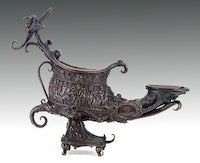Andrea Riccio: Renaissance Master of Bronze
October 15, 2008 through January 18, 2009
Exhibition Checklist
 |
|
The Cadogan Lamp
c. 1507–10
Bronze
Victoria and Albert Museum, London
Cat. No. 13 |
The Cadogan Lamp takes the form of an ancient Roman
ship. The wick pan for the lighted flame is on the prow.
Tritons and nereids frolic in the waves along the hull.
A now lost figure, perhaps a helmsman, may have been
secured over the hole on the poop deck. This complex
bronze may allude to the Ship of Fortune that can be guided
by the virtuous light of reason. On the hull, one allegorical
medallion (showing a nude woman) condemns the ignorant,
another (showing a youth tethered to a tree) counsels
deliberation. Like many of the works in this gallery, Riccio
created this bronze as a unique cast. It probably was
a centerpiece in a scholar’s study, admired both for its
exquisite artistry and resonant meaning.
 |
|
Oil Lamp
c. 1516–24
Bronze
The Frick Collection, New York
Cat. No. 14 |
The Frick Oil Lamp is a bravura performance of the bronzemaker’s
art. Its long heavy body is perfectly balanced on an
improbably small foot. Riccio modeled each tiny figure and
form directly in the wax, scoring their outlines with sharp
tools. The swift movements of his hand are immaculately
preserved in the bronze cast. Garlands, fantastic masks, and
narratives of putti performing pagan rituals embellish every
surface. Vinelike forms curl out from the lamp, recalling the
twisting movement of its lighted flame. The Frick lamp and
stylistically similar masterpieces, like The Shouting
Horseman and Orpheus, illustrate how Riccio
applied his inventive powers equally to the figurative and
so-called decorative arts.
 |
|
Winged Putto
c. 1500–15
Bronze
Victoria and Albert Museum, London
Cat. No. 15 |
Riccio populated his bronzes with innumerable little putti —
some solemn, some jubilant, and many music-making. This
Putto’s original context is unknown, but it was surely part
of a larger ensemble. Small figures like this one often crowned
Riccio’s functional bronzes. A smaller version of the Putto may have sat atop an object, as did the lost putto that
Licetus illustrated decorating the Frick Oil Lamp.
 |
|
Illustration:
The Frick Oil Lamp, engraving from Licetus, De lucernis . . . ,
1652 |
 |
|
Carrand Vessel
after 1516 (?)
Bronze
Museo Nazionale del Bargello, Florence
Cat. No. 16a
Cover of the Carrand Vessel
after 1516 (?)
Bronze
Victoria and Albert Museum, London
Cat. No. 16b |
This Vessel and its Cover are reunited in the exhibition for the
first time. The cover was designed to slide into the grooves
along the vessel’s open back. What it contained has up to now
been a mystery.
Like Riccio’s oil lamps, the covered Vessel is a luxury object
intended for use and display in the scholar’s study. It is
probably a bronze interpretation of the leather pouches used
to hold quill tips. The Vessel’s stylized cornucopia shape and
fruit-bearing crown allude to the copious wealth of words
brought forth by those writing tools. On the Vessel, putti
play music and one inscribes a tablet to celebrate the triumph
of writing. This tiny bronze monument to the written word
is an eloquent example of Riccio’s ability to transform the
grand aspirations of his scholarly patrons
into singular works of art.
 |
|
The Fortnum Lamp
1500–10
Bronze
Ashmolean Museum, Oxford
Cat. No. 17 |
All but one of the five oil lamps commonly attributed to
Riccio are assembled here. Oil lamps were among the most
highly prized objects in the Renaissance scholar’s study.
Their intricate designs and detailed narratives, realized in
exquisitely small scale, were meant to be explored and contemplated
over long, repeated viewings. The Fortnum Lamp shares some of the distinctive features of the other lamps —
like figurative medallions and hooked feet — but in simpler
form, and its shape closely depends on classical prototypes.
 |
|
In the manner of Riccio
Oil Lamp
Padua, mid-sixteenth century (?)
Bronze
Musée du Louvre, Paris, Département des Objets d’Art
Cat. No. 29 |
Bronze oil lamps are a genre specifically associated with
Riccio. The Louvre lamp’s traditional assignment to the master
was based on the similarity of its burial scene to reliefs such
as the Entombments exhibited here. This lamp, however, is
most likely a derivative pastiche of Riccio’s work. The figures
project uniformly, and they lack the sharp incised outlines
made by Riccio’s stylus scoring into the wax model, as seen
on the Cadogan and Frick lamps. This bronze also lacks the
concave hammer strokes that Riccio laid over the other
lamps’ metal surfaces. The top of the Louvre lamp may
have been soldered onto the bowl at a much later date. Continue >>>
|


